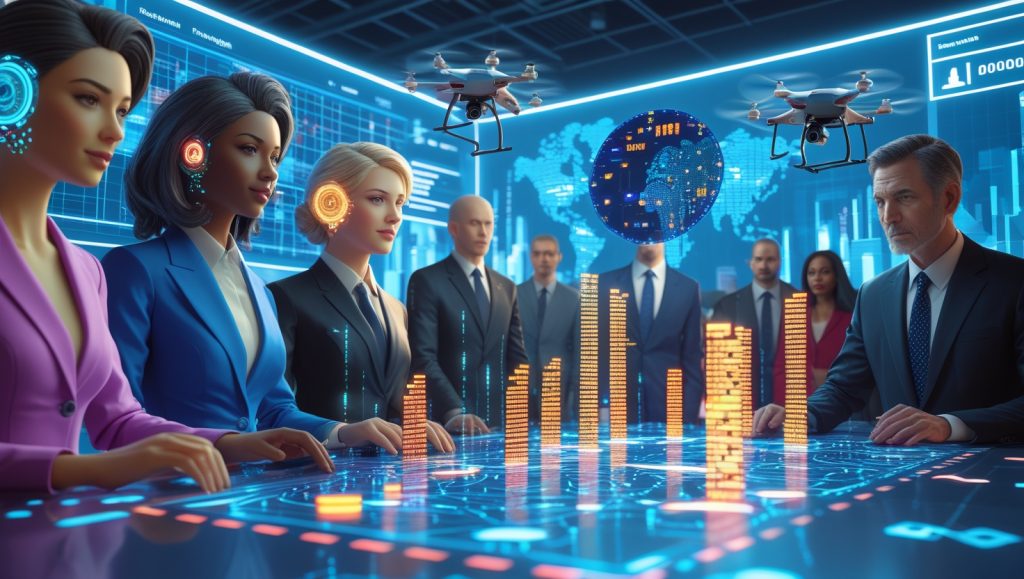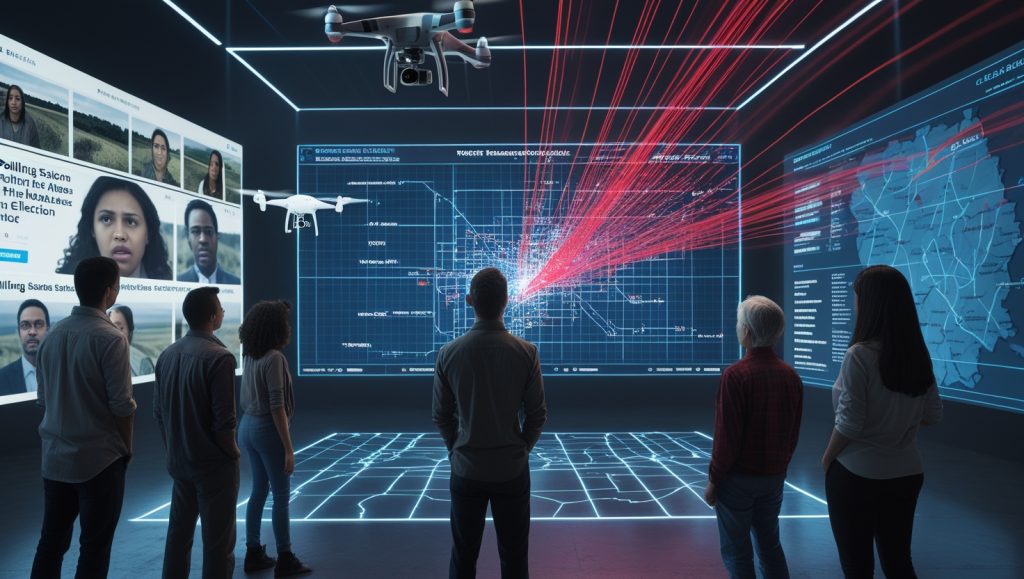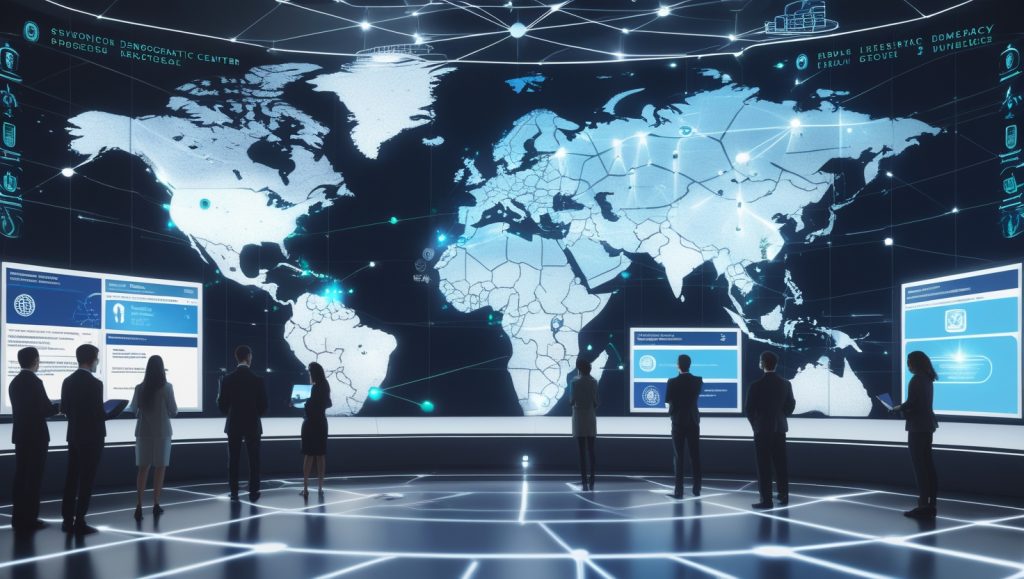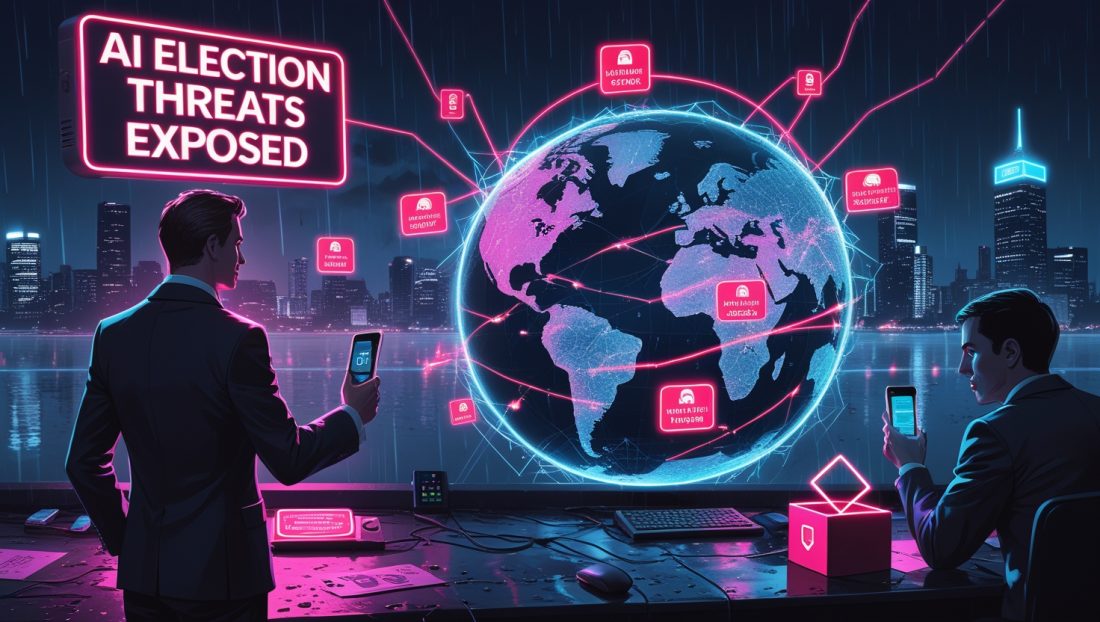Can Artificial Intelligence Dismantle Democracy?
In early 2025, robocalls targeting EU parliamentary elections used AI to mimic local leaders, urging voters to skip polling stations. This escalation of AI election threats marks a crisis accelerating ahead of 2025’s pivotal global elections. From India’s AI-generated campaign ads to Slovakia’s viral deepfake audio, artificial intelligence has become democracy’s paradoxical ally and adversary.
This analysis dives into how AI election threats are reshaping political campaigns, amplifying disinformation, and testing public trust in electoral systems. With insights from cybersecurity experts, policymakers, and real-world case studies, we unravel strategies to protect democracy’s future while harnessing AI’s potential for good. For a deeper look at AI’s darker side, explore how the dark side of AI threatens our future with deepfakes and surveillance.
Section 1: AI in Political Campaigns – The Double-Edged Sword of Innovation

Hyper-Personalization: Campaigns at Scale
AI’s ability to micro-target voters is unprecedented. In Japan’s 2023 Tokyo assembly race, independent candidate Takahiro Anno deployed an AI avatar to answer 8,600 policy questions in real time, securing fifth place despite minimal funding. Meanwhile, Pakistan’s imprisoned former Prime Minister Imran Khan used an AI voice clone to bypass media bans, broadcasting speeches to millions on TikTok. These advancements highlight why AI election threats arise when such tools are misused to manipulate voter perceptions.
The rise of AI avatars in campaigns underscores a broader trend: technology’s ability to democratize access while amplifying risks. In the 2025 EU elections, AI bots posing as local candidates on social media amplified AI election threats, with synthetic profiles swaying undecided voters. To understand how AI is reshaping other sectors, check out why AI in judicial decisions is sparking breakthroughs and controversies.
Key Insight:
“AI levels the playing field for underfunded candidates but risks flooding voters with synthetic interactions.”
– Darrell West, Senior Fellow, Brookings Institution
Why AI Fundraising and Polling Spark Ethical AI Election Threats
AI tools like Quiller draft fundraising emails optimized for donor psychology, while platforms like Polis use machine learning to simulate voter sentiment. However, these innovations raise alarming questions:
- Privacy Violations: Campaigns scrape social media data to build voter profiles, often without consent.
- Synthetic Polling: AI-generated “phantom voters” distort polling accuracy, as seen in Brazil’s 2025 municipal elections, where bots inflated support for populist candidates, intensifying AI election threats.
The ethical dilemmas of AI in fundraising extend beyond privacy. AI tools exploit psychological triggers, crafting emails that prey on fear or hope to boost donations, contributing to AI election threats when used irresponsibly. In Europe’s 2025 parliamentary elections, AI-driven polls overestimated far-right support due to bot-driven data, skewing campaign strategies. For a related discussion on AI’s ethical challenges, see why AI ethics could save or sink us. These practices erode trust, making it critical to address AI election threats through transparent AI use in campaigns.
Fictional Anecdote (Labeled as Fiction):
Imagine “Carlos,” a city council candidate whose AI chatbot promises lower taxes to conservatives and green policies to progressives. While engagement soars, voters later feel manipulated—a microcosm of AI’s trust paradox.
Section 2: AI-Generated Misinformation – The Global Disinformation Arms Race
Why Deepfakes Are Strategic Weapons in AI Election Threats
In 2025, deepfake technology remains a geopolitical tool, amplifying AI election threats:
- India: AI-generated videos of regional leaders endorsing controversial policies resurfaced during 2025 state elections, fueling AI election threats and communal tensions.
- Slovakia: Fake audio of liberal candidate Michal Šimečka discussing vote rigging spread on Facebook just days before the 2023 election, a tactic echoed in 2025’s local races.
- United States: Early 2025 saw a fabricated video of a presidential candidate in a scandalous meeting, amassing 15 million views on X, highlighting ongoing AI election threats.
Deepfakes are strategic weapons in AI election threats, capable of swaying public opinion overnight. In Nigeria’s 2025 governorship elections, deepfake videos falsely showed a candidate endorsing separatist movements, sparking unrest. The accessibility of tools like DeepFaceLab has lowered the barrier for creating convincing fakes, making regulation urgent. For a global perspective on AI’s electoral impact, see the Brennan Center’s analysis of AI-driven disinformation in 2024 elections, which foreshadows 2025’s challenges. For more on deepfake risks, read why humanoid robots creep us out and how close they are to becoming unsettlingly real, which touches on AI’s uncanny realism.
Statistic:
87% of disinformation researchers in 2025 rank AI election threats above cyberattacks as the top risk to democracy, up from 83% in 2024.
Why Encrypted Apps Amplify AI Election Threats
Platforms like WhatsApp and Telegram enable AI-generated falsehoods to bypass content moderation, exacerbating AI election threats:
- Brazil: Deepfake audios targeting Brazil’s 2025 municipal elections spread via WhatsApp, falsely depicting candidates supporting radical policies.
- Burkina Faso: AI-generated propaganda videos on Telegram in 2025 continue to destabilize democratic transitions, with AI election threats undermining public trust.
Encrypted apps create a shadow network for AI election threats, where disinformation spreads unchecked. In Thailand’s 2025 general elections, Telegram channels circulated AI-generated images of opposition leaders at illicit events, undermining their credibility. The anonymity of these platforms complicates tracking, as seen in why drone delivery networks face similar challenges with untraceable tech. Governments must balance privacy with accountability to curb these AI election threats.
“Encrypted apps are the new battleground. We’re fighting AI disinformation with one hand tied behind our backs.”
– Dr. Joan Donovan, Harvard Kennedy School
Section 3: Voting Integrity – How AI Undermines Trust in Democracy

Why Cheap Fakes Pose Potent AI Election Threats
While deepfakes dominate headlines, crudely edited “cheap fakes” remain potent in areas with limited internet literacy, contributing to AI election threats:
- Mexico: AI-altered videos in Mexico’s 2025 state elections falsely showed governors banning religious festivals, fueling protests.
- Philippines: Manipulated clips of a 2025 senatorial candidate appearing incoherent at rallies lowered their approval ratings by 9%.
Cheap fakes are a low-cost, high-impact tool in AI election threats, exploiting trust in visual media. In Kenya’s 2025 county elections, manipulated images of a candidate with illegal arms swayed rural voters, where fact-checking resources are scarce. These tactics thrive in regions with low media literacy, underscoring the need for grassroots education. For insights on combating misinformation, see why AI in disaster response leverages similar community-driven solutions.
Solution Spotlight:
Ghana’s FactHub initiative reduced misinformation impact by 30% through radio-based fact-checking partnerships with local DJs.
Why AI-Driven Voter Suppression Intensifies AI Election Threats
Beyond disinformation, AI enables precision voter suppression, a growing facet of AI election threats:
- Microtargeted Discouragement: In Georgia’s 2025 local elections, AI-generated texts targeting minority districts falsely warned of “voter ID crackdowns,” suppressing turnout.
- Algorithmic Gerrymandering: AI tools like RedMap, used in Australia’s 2025 redistricting, diluted Indigenous voting power by 12%.
Voter suppression via AI is a sophisticated threat, leveraging data analytics to target vulnerable groups. In South Africa’s 2025 provincial elections, AI-generated robocalls falsely informed rural voters of polling station closures, reducing turnout by 2%. Such tactics mirror broader AI misuse, as discussed in why self-driving cars’ hidden flaws reveal tech’s limitations. Addressing these AI election threats requires robust data privacy laws and real-time monitoring.
Section 4: Case Studies – Lessons from the Frontlines
Case 1: The New Hampshire Robocall Scandal – A Blueprint for Accountability
When AI cloned President Biden’s voice to suppress primary turnout in 2024, authorities traced the attack to a Texas-based MAGA operative using ElevenLabs’ voice synthesis tool. The incident exposed critical gaps:
- Regulatory Void: By mid-2025, 28 U.S. states have enacted laws against AI impersonation, but gaps remain in federal oversight.
- Platform Complicity: Despite 2025 upgrades to telecom protocols, some robocalls still evade detection.
The New Hampshire scandal revealed how AI election threats exploit outdated systems. Similar incidents, like AI-generated robocalls in Canada’s 2025 federal elections, highlight the need for universal watermarking. For a related perspective, explore why explainable AI (XAI) is crucial for trustworthy tech, emphasizing transparency in AI applications.
Outcome:
New Hampshire lawmakers fast-tracked the AI Transparency Act, mandating watermarking for political audio/video content.
Case 2: India’s Deepfake Election – Synthetic Media Goes Mainstream
With 1.4 billion people and 50% internet penetration in 2025, India’s state elections face ongoing AI election threats:
- Digital Resurrection: AI avatars of historical figures are used across party lines, raising ethical concerns.
- Multilingual Disinformation: AI-generated videos in 15 regional languages overwhelm fact-checkers.
India’s experience with AI election threats underscores the challenge of scale in diverse democracies. AI tools translated disinformation into regional dialects, amplifying reach in 2025 state elections. This mirrors trends in why AI-powered podcast translation is breaking language barriers, where AI’s linguistic capabilities are dual-use. India’s response—deploying AI-based fact-checking bots—offers a model for 2025.
Statistic:
Fact-checkers debunked 70,000+ AI-generated posts during India’s 2025 state elections—a 25% increase from 2024.
Section 5: Safeguarding Democracy – A 2025 Roadmap

Strategy 1: Digital Provenance Standards
The UK’s authenticity-by-design framework, fully implemented in 2025, embeds cryptographic watermarks in AI content, reducing deepfake visibility by 75% across platforms like Meta and YouTube.
Strategy 2: Global AI Election Monitoring
Modeled after nuclear nonproliferation treaties, the Global Partnership on AI Safety (GPAIS) launched in 2025 to:
- Share threat intelligence across 78 member nations
- Standardize penalties for AI election interference
- Fund media literacy programs in vulnerable regions
Strategy 3: Grassroots Media Literacy
South Africa’s Real411 platform lets citizens report disinformation via WhatsApp, with verified debunks aired on national TV. Similar systems are being adopted in Colombia and Indonesia.
Statistic:
Countries with national media literacy programs saw 40% slower disinformation spread during elections.
FAQ: Your Top Questions on AI Election Threats
Can AI actually change election outcomes?
In 2025, AI-driven disinformation in tight races, like Mexico’s state elections, is suspected to have shifted outcomes by 1–2%, with AI election threats targeting swing voters.
How can I spot AI-generated election content?
Look for mismatched lip-syncing, unnatural blinking in videos, or generic language in text. Use tools like Intel’s FakeCatcher or the Coalition for Content Provenance’s authentication plugin.
Are governments regulating AI inpolitics?
The EU’s AI Act, strengthened in 2025, imposes fines for undisclosed synthetic content, while 35 U.S. states mandate AI disclosure in political ads, though enforcement varies.
Democracy’s Fight for Survival in the AI Age
The AI election threats we face are not technological inevitabilities but political choices. As Taiwan’s Digital Minister Audrey Tang argues, “We can design AI that amplifies truth instead of terror.” From watermarking laws to grassroots education, solutions exist—but they demand urgent global cooperation. For more on AI’s transformative potential, read why small businesses can’t ignore AI to survive.
Your Role in This Fight:
- Verify Before Sharing: Use tools like InVID to check suspicious content.
- Advocate for Regulation: Support laws like California’s Deepfake Accountability Act.
- Stay Informed: Subscribe to our newsletter for monthly updates on AI and democracy.


